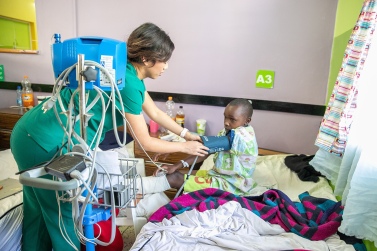
Patty Olino, @scrubsandstripes on Instagram, and I traveled to CURE Kenya this month and our worlds will never be the same. We got to experience just how similar and how different healthcare can be in a foreign country.
LICENSURE
Let’s begin at the core. To become a nurse in Kenya requires a diploma in nursing. This is the equivalent to an associate’s in nursing in the states. Nurses must then pass their licensure exam before they can practice as a nurse.
HOURS
We saw numerous roles of the nurse in Kenya: bedside, scrub nurse, PACU, ICU, charge nurse, etc. We found that the surgical team worked anywhere from eight to ten hours a day, five days a week beginning at 0730AM. The nurses working on the wards would work three twelve hour shifts a week alternating from day shifts one week to night shifts the next.
PAY
The nurses say they make enough money to “have a nice life.” Lots of things must be considered. The cost of living is a lot lower in Kijabe than it is in California. However, most of the nurses are able to afford traveling and living alone.
UNIFORM
Little did we know how much of an impact we would make at CURE in regards to their uniforms. For three years, the nursing staff had been begging to ditch their pencil skirts and CURE polo shirts for nursing scrubs. However, the budget wouldn’t allow this change. It wasn’t until we came along with our donated Figs that their uniforms changed! Prior to our gorgeous, royal purple Figs scrubs, the ward nurses worse blazers, skirts, and a collared shirt. The theater (operating room) staff wore thin, one size fits all scrubs.
FAMILY INVOLVEMENT IN CARE
One thing that was a huge difference between American nursing and nursing in Kenya was the family involvement in care. Every pediatric patient admitted had a family member admitted with them, usually a parent. This parent also wears a hospital gown and sleeps in bed with the patient. The parents are responsible for all activities of daily living (ADLs) like feeding, bathing, linen changes, and general hygiene. This leaves the nursing care as the sole focus of the nurse.

NURSE SCOPE OF PRACTICE
While in Kenya we realized that nursing is the same in America as it is at CURE. The fundamentals of nursing are the same. The overall focus is on taking care of the patient through nurturing.
One difference was the limited resources available. Since there isn’t a surplus of medications, narcotics can only be given if they are very necessary. Because of this, the patients are so strong! They will only ask if they truly need it. Unfortunately, there is some abuse in America so working at CURE was so refreshing!
Since the families are so involved in care, it leaves medications, assessments, and vitals for the ward nurse to complete. This may seem like it isn’t very much but given the nurse:patient ratios it is a very large task.

NURSE-PATIENT RATIOS
Nurses have very high nurse-patient ratios. Because of this, family involvement in care is imperative. The nurses on the ward had upwards of twelve patients to one nurse! This is very different from America, however doable because of the family involvement in care.

WHY NURSING?
When we asked the nurses why they chose nursing as their career, they all answered: “It was a calling.” Despite the long hours and hard work, the nurses in Kenya felt called to action, the same way many of us feel.
There was something so special working alongside these nurses in Kenya. They reminded me to remember the fundamentals of nursing. They practice nursing with their hearts, not completing tasks quickly just to get them done. They take their time, utilize therapeutic communication, nurture, and soothe the children. Watching them practice nursing at the core was inspiring.

I have relearned things about nursing that I will never forget. It is easy to get distracted by the shiny new toys and technologies of medicine. But in the end, it is about the patient and your connection. This is why I am a nurse, to form these bonds and make a difference. The nurses at CURE are making a difference and I am so blessed to have been a part of it.
All patients in the above images and videos have signed consents. CURE is a nonprofit organization that survives off of donations. Social media is a huge part of their success and is necessary to allow CURE to keep changing patients’ lives for the better.



























